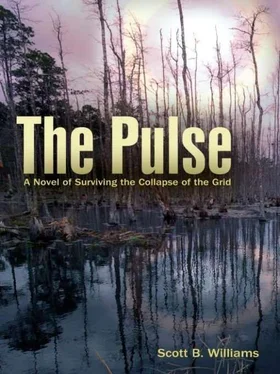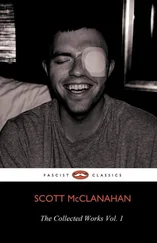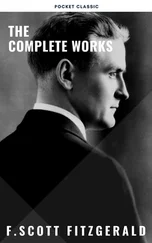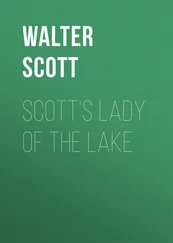“You freakin’ sailors are absolutely insane!” he said to Larry as his brother handed him his first cup of coffee of the day.
“It’s all in a day’s work, Doc. You gotta weather a few storms if you want to drop anchor in paradise. Hell, if it weren’t for a good gale now and then, the sea would be crowded with landlubbers sailing all over the place.”
“I’ve never been so scared in my entire life.”
“A hot electrical storm like that can get pretty intense, but we really were in no danger. What’s bad is when you get caught in those kinds of squalls close to land. Then you’re in real danger of getting blown ashore or run down by a barge or any number of coastal vessels. Out here, there’s nothing to hit for a hell of a long way.”
“So how far did we get blown off course, and how long will it take to make up for it?”
“It’s not as much as you think. We might’ve got set about 10 miles east of our rhumb line, but I can’t be sure without the GPS. If I can get a clear shot of the sun at noon with the sextant, I can tell you to within a mile, anyway. Of course we lost a few hours of distance made good on our heading, but we’ll make it up as soon as the wind fills in. It looks like it’s picking up now, so we’d better take advantage of it and get up all the sail we can carry.”
Once they were back on course, after Larry confirmed their position with a noon sight shot with the sextant, they were able to take advantage of a steady southwest wind that leveled out around 15 knots in the afternoon and lasted through the next night. Steady sailing on a beam reach in this wind put them within 110 miles of the northern Gulf coast by the next morning. In this area, near the edge of the continental shelf, they began encountering offshore oil platforms, and by noon had sailed past dozens of these huge structures standing on stilt-like legs above the Gulf. All of them were shut down, of course, and there was none of the heavy boat traffic among them that Larry said would be a hazard to navigation in typical conditions. Nevertheless, he insisted on steering well clear of them, so that they didn’t pass closer than a mile to any of them.
“Do you think any of the crews are still out here, stranded?” Artie asked.
“Probably not, after this much time. I mean, they certainly wouldn’t be able to go home by helicopter, like they usually do, but these rigs all have some top-notch diesel mechanics keeping everything running. I would imagine that by now they’ve managed to get enough of the crewboats started to get everyone to the mainland. They certainly have enough fuel on hand, as well as tools and spare parts.”
“They must have gotten as good of a view of the flash as I did, that first night.”
“Yeah, I can imagine. Anyway, I’m just glad our timing worked out to cross this oilfield in daylight. You can see what a nightmare it would be to try to sail through here in the dark with all these rigs unlit. If this wind holds, we’ll be past the danger zone before it gets dark again, but then we’ve got to worry about our speed, because we’ll be making landfall before daylight.”
Larry got out his chartbook for the northern Gulf coast and showed Artie a chart called “Mississippi Sound and Approaches.” He pointed out the long chain of barrier islands that created the sound and paralleled the mainland from the Florida-Alabama state line to the entrance to Lake Pontchartrain.
“I never knew all those islands existed,” Artie said.
“Most of them are reachable only by boat, and are part of a national seashore preserve. There’s a lot of shoal water around them and inside the sound. This whole coast is hazardous to any deep-draft boat, in fact. We don’t have to worry as much as most, with the catamaran, but we’ve still got to stay on top of where we are. You could run a skiff aground on some of the sandbars around those islands. Look, here’s where we want to enter the sound.” Larry pointed at a marked channel leading in from the Gulf to the west side of a barrier island labeled West Ship Island. The channel continued north for miles across the sound to the city of Gulfport, Mississippi. “I’ve run that channel before, and we can do it at night, as long as there’s some moonlight, which we’ll have plenty of. We’ll drop anchor behind Ship Island and wait for dawn. From there, it’s less than a day’s sail to the west end of the sound and the entrance to Pontchartrain.”
“I can’t believe we’re almost there. It seemed like we were a world away when we first talked about this voyage in St. Thomas.”
“It’s a pretty good trip, no doubt. A couple more like that, and I’ll make a sailor out of you yet, Doc.”
“One’s enough, thanks. Except I know you’re going to tell me we’ve got to sail away somewhere else once we pick up Casey.”
“I don’t have a better answer, do you? I don’t know where we’d go or what we’d do on the mainland. You sure wouldn’t likely be able to get to your house right now. But we’ll figure all that out later. The main thing is to get to Casey first.”
When the last of the oil platforms dropped astern, the sun was setting on the Gulf and they were once more in open water. Larry calculated it was less than 30 miles to West Ship Island, but said it was so low lying, they wouldn’t see it until they were within five miles of it. Once it was fully dark, Artie helped Scully put a reef in the main so they could maintain a slower approach while they waited for the moonrise. Two hours later, they were able to pick out the unlit markers indicating the Gulfport Ship Channel in the moonlight. On the horizon to the north, a faint line of white sand could be seen, and soon they heard the distant sound of crashing surf as they sailed closer to the island. Artie was eager and elated at the prospect of the end of the voyage. But he was also disappointed to see that there were no lights or even a distant glow in the direction of the mainland, where he knew, from driving it, that there was almost a solid line of urban sprawl from New Orleans to Mobile, Alabama. From what they could tell so far, the entire coast was as dark as the uninhabited barrier island they were approaching.
When they were closer to the island, Larry pointed out an odd, circular structure rising some 30 feet above the otherwise featureless dunes of the island. “In the daylight, we would have seen that before we could have seen the beaches. It’s Fort Massachusetts, built after the War of 1812. It’s a park now, and there is a dock near it on the north side of the island where excursion boats land to bring tourists out here. We can anchor around there on that side. It’s the best harbor at any of these islands, which is why they built the fort there in the first place, to guard the approach to New Orleans.”
Artie was surprised at how brightly the white sand beaches of the island glowed in the moonlight. It was almost like daylight against that white sand, and he could clearly see the outlines of the dunes and the sea oats that grew on them as they rounded the west end of the island and entered the sound to turn east to the anchorage area. The long excursion boat dock came into view, and as they sailed past the end of it, they saw something else—a small campfire on the beach, situated in a hollow between the high dunes that had made it invisible to them from the Gulf side of the island. A few yards out in the water from the fire, leaning over several degrees from upright, was a small monohull sailboat that was apparently aground on the bottom. Two anchor rodes could be seen leading from its bow and stern out to deeper water, and there was a third trailing off towards the beach. As soon as the Casey Nicole appeared past the pier, someone by the fire jumped up and began yelling and waving for help.
Читать дальше












